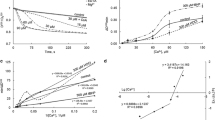Abstract
When loaded with high (pathological) levels of Ca2+, mitochondria become swollen and uncoupled as the result of a large non-specific increase in membrane permeability. This process, known as the mitochondrial permeability transition (MPT), is exacerbated by oxidative stress and adenine nucleotide depletion. These conditions match those that a heart experiences during reperfusion following a period of ischaemia. The MPT is caused by the opening of a non-specific pore that can be prevented by sub-micromolar concentrations of cyclosporin A (CsA). A variety of conditions that increase the sensitivity of pore opening to [Ca2+], such as thiol modification, oxidative stress, increased matrix volume and chaotropic agents, all enhance the binding of matrix cyclophilin (CyP) to the inner mitochondrial membrane in a CsA-sensitive manner. In contrast, ADP, membrane potential and low pH decrease the sensitivity of pore opening to [Ca2+] without affecting CyP binding. We present a model of pore opening involving CyP binding to a membrane target protein followed by Ca2+-dependent triggering of a conformational change to induce channel opening. Using the ischaemic/reperfused rat heart we have shown that the mitochondrial pore does not open during ischaemia, but does do so during reperfusion. Recovery of heart during reperfusion is improved in the presence of 0.2 µM CsA, suggesting that the MPT may be critical in the transition from reversible to irreversible reperfusion injury. (Mol Cell Biochem 174: 167–172, 1997)
Similar content being viewed by others
References
Hunter DR, Haworth RA: The Ca2+-induced membrane transition in mitochondria. I. The protective mechanisms. Arch Biochem Biophys 195: 453–459, 1979
Bernardi P, Broekemeier KM, Pfeiffer DR: Recent progress on regulation of the mitochondrial permeability transition pore; A cyclosporin and toxic effects of cyclosporin. Biochem J 274: 611–614, 1991
Connern CP, Halestrap AP: Purification and N-terminal sequencing of peptidylprolyl cis-trans-isomerase from rat liver mitochondrial matrix reveals the existence of a distinct mitochondrial cyclophilin. Biochem J 284: 381–385, 1992
Bergsma DJ, Eder C, Gross M, Kersten H, Sylvester D, Appelbaum E et al.: The cyclophilin multigene family of peptidyl-prolyl isomerases – characterization of three separate human isoforms. J Biol Chem 266: 23204–23214, 1991
Halestrap AP: Calcium-dependent opening of a non-specific pore in the mitochondrial inner membrane is inhibited at pH values below 7 – implications for the protective effect of low pH against chemical and hypoxic cell damage. Biochem J 278: 715–719, 1991
Connern CP, Halestrap AP: Recruitment of mitochondrial cyclophilin to the mitochondrial inner membrane under conditions of oxidative stress that enhance the opening of a calcium-sensitive non-specific channel. Biochem J 302: 321–324, 1994
Connern CP, Halestrap AP: Chaotropic agents and increased matrix volume enhance binding of mitochondrial cyclophilin to the inner mitochondrial membrane and sensitize the mitochondrial permeability transition to [Ca2+]. Biochemistry 35: 8175–8180, 1996
Griffiths EJ, Halestrap AP: Protection by cyclosporin A of ischemia reperfusion-induced damage in isolated rat hearts. J Mol Cell Cardiol 25: 1461–1469, 1993
Nazareth W, Yafei N, Crompton M: Inhibition of anoxia-induced injury in heart myocytes by Cyclosporin-A. J Mol Cell Cardiol 23: 1351– 1354, 1991
Griffiths EJ, Halestrap AP: Mitochondrial non-specific pores remain closed during cardiac ischaemia, but open upon reperfusion. Biochem J 307: 93–98, 1995
Broekemeier KM, Carpenter-Deyo L, Reed DJ, Pfeiffer DR: Cyclosporin-A protects hepatocytes subjected to high Ca2+ and oxidative stress. FEBS Lett 304: 192–194, 1992
Pastorino JG, Snyder JW, Hoek JB, Farber JL: Ca2+ depletion prevents anoxic death of hepatocytes by inhibiting mitochondrial permeability transition. Am J Physiol 37: C676–C685, 1995
Pastorino JG, Snyder JW, Serroni A, Hoek JB, Farber JL: Cyclosporin and carnitine prevent the anoxic death of cultured hepatocytes by inhibiting the mitochondrial permeability transition. J Biol Chem 268: 13791–13798, 1993
Nieminen AL, Saylor AK, Tesfai SA, Herman B, Lemasters JJ: Contribution of the mitochondrial permeability transition to lethal injury after exposure of hepatocytes to t-butylhydroperoxide. Biochem J 307: 99–106, 1995
Author information
Authors and Affiliations
Rights and permissions
About this article
Cite this article
Halestrap, A., Connern, C., Griffiths, E. et al. Cyclosporin A binding in mitochondrial cyclophilin inhibits the permeability transition pore and protects hearts from ischaemia/reperfusion injury. Mol Cell Biochem 174, 167–172 (1997). https://doi.org/10.1023/A:1006879618176
Issue Date:
DOI: https://doi.org/10.1023/A:1006879618176




